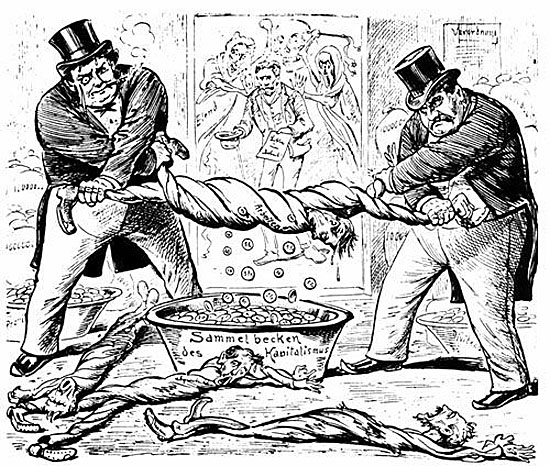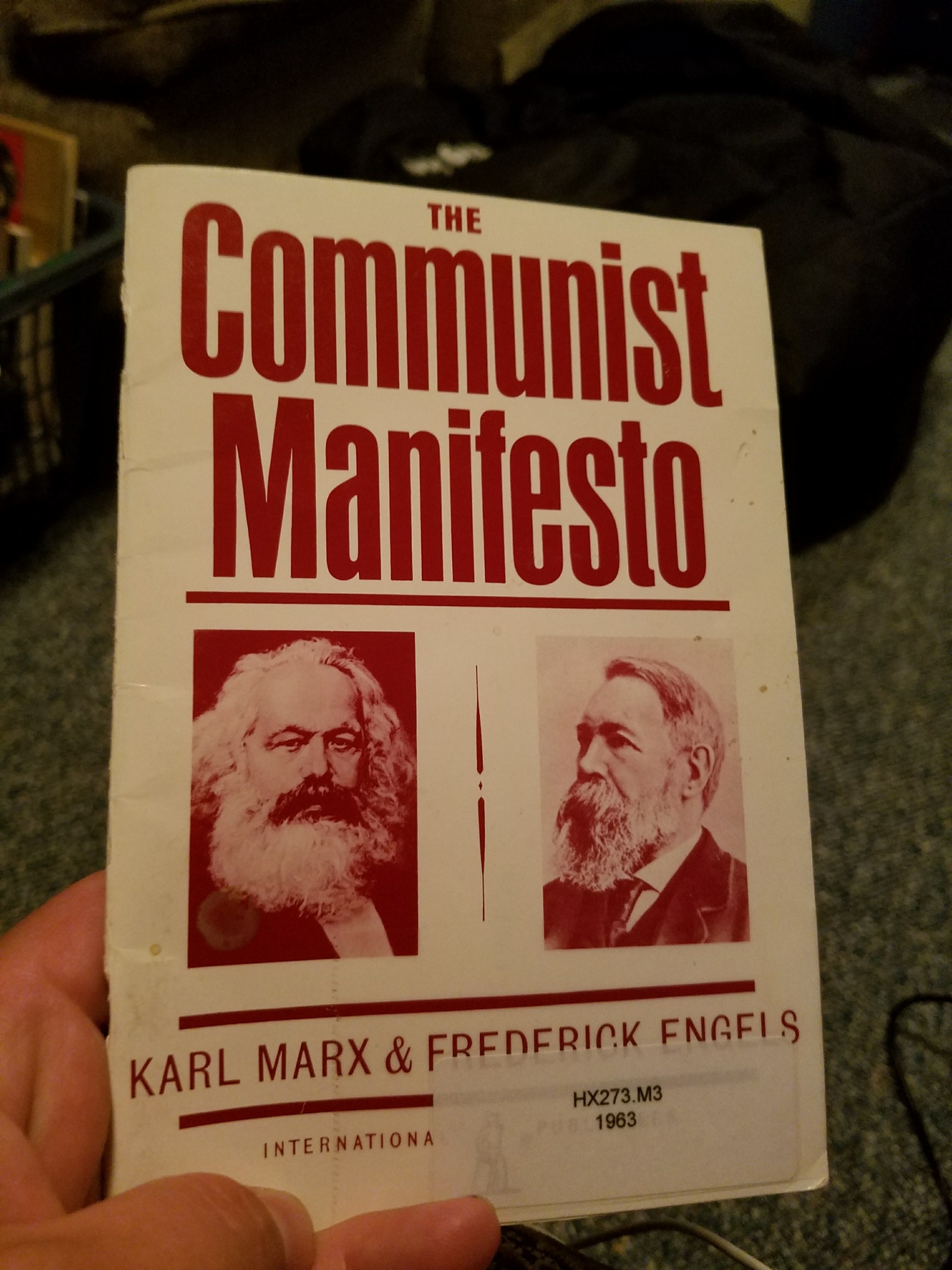
Capitalists have had a problem with communism since its inception. In the second part of The Communist Manifesto (third part in my series; other parts here), the authors described how communists related to the proletariat. Communists connected similarities between the European workers’ parties that went beyond national identity (e.g., workers have the same relation to capitalists in England as they do in Poland). Marx and Engels responded to six (technically seven) objections that the bourgeois brought against the communists, and to that we turn. As before, I will try to update some of their language to the present. E.g., I’ll render “bourgeoisie” as “owners,” or “capitalists,” or the “proletariat” as “working class” or “workers.”
The 6 Objections Owners Had with Communism
- Communists deny the worker the fruit of his labor
- Communists destroy individuality
- Those dern communists do away with property
- Commies dismantle the family and disrupt family education
- Communists desire to share women in common
- Communists dissolve nationalities/countries
The main structure of these objections lies in stating a bourgeois objection, explaining how the bourgeoisie critiques communists according to naturalized categories, and then asserting that what the bourgeois consider as neutral categories (e.g., “the” family, “the” individual, “freedom,” etc.) are actually nuanced by class.
Objections #1: Communists Deny the Worker the Fruit of His Labor
Capitalists, according to Marx and Engels, claimed that communists sought to deny the worker what he had made through his labor: the fruit or product. Workers had this relation to their labor before capitalism. E.g., under feudalism, peasants had to render tribute from their crops, but lords did not own all crops and then sell it back to peasants. This property relation comes under capitalism.
Under the “wage-labor” system of capitalism, a worker receives compensation not in what he produces, but with a wage far below the value he produces. It cost Apple $236 to produce the iPhone 6s Plus, though it sold for $749. In 24 hour cycles, 200K workers were building 540K iPhones daily. At that rate, each worker was producing 2.7 iPhone 6s Pluses per day, which would net Apple $1385.10 ((749-236)*2.7).
You and I both know that most top managers weren’t even making a quarter of $1300 per day. Let’s say the worker is well compensated at $25 an hour. Working 8 hours a day, 5 days a week, the same worker who produced 2.7 iPhones per day could not afford to buy the phone outright without almost 4 days’ pay. Admittedly, most people buy on installment plans, helping communications capitalists, but the point stands.
The communists, according to Marx and Engels, wanted to do away with “private property” and move it to worker ownership. In this way of things, the workers (not the shareholders) would own the means of production AND what they produced, drastically altering the relation between persons and capital. By abolishing private property, the authors do not mean taking your iPhone, dog, and fleshlight. One, these would be products you produced yourself. Two, since production occurs for need instead of profit, a new relation develops between humans and commodities.
Objections #2: Communists Destroy Individuality
In the authors’ argument, this objection follows closely from the first. Capital is both the means of production and the product itself. For example, the machines used to assemble iPhones, along with iPhones themselves, are capital that belong to the capitalist class.
What the authors get at is that capitalists mistake their class’s view of individuality with individuality itself (cf. my post on naturalization).
Even if it was a capitalist who originated the idea for the iPhone, the capitalist cannot possibly realize this dream without a mass of labor. However, he attains a social status for the idea/product while the workers remain in the background.
When you think of the Apple brand, who do you picture? Do you think of the thousands of workers involved in producing, transporting, stocking, and selling Apple products? Or do you think of Steve Jobs? This is the individuality communists seek to destroy—a self that is not possible without a largely exploited mass. The communists wish to re-inscribe their individuality.
Objections #3: Those Dern Communists Do Away with Property
Somewhat related to objection 1, owners claimed that communists wanted to abolish private property. Marx and Engels pled guilty. Capitalists equated property with productive property/the means of production. They “rented” this to workers in the form of a wage.
.Capitalists propagated the claim that if property ceased, then work would cease, and universal laziness would follow in this train. Our authors wryly put it,
“You are horrified at our intending to do away with private property. But in your existing society, private property is already done away with for nine-tenths of the population; its existence for the few is solely due to its non-existence in the hands of those nine-tenths” (25).
And guess what: the poor still worked in order to survive. They did not toil for their own needs, which might take roughly 4 hours a day to meet if they lived in a forest commune. No, they worked arbitrarily long hours to create enormous surpluses of products, the profits of which all went back to the capitalists.
Communists wanted, not to leech peoples’ property, but to prevent the already-occurring exploitation of the workers by the capitalists.
Objections 4: Commies Dismantle Family and Disrupt Family Education
This objection is a bit obtuse if you don’t know what’s going on in the background. The authors frame this as yet another case of the bourgeoisie mistaking its own concept of the family for the family itself.
Marx and Engels describe this bourgeois family as based “on capital, on private gain” in contrast with the “practical absence of the family among the proletariat.” I’m not sure what goes on here. Later they remark that they wish to end parental exploitation of their children. It remains unclear, however, if the authors mean bourgeois children, proletarian children, or children in general.
On r/Communism101, u/Ornlu_Wolfjarl claims that the communist aim to end the capitalist family was to remove inheritance rights, and therefore, the propagation of class. This makes sense, for at the end of this section, the authors call on banning all inheritance. U/laserbot claims something similar, in that commies were not about ending marriage or parent/child relations per se, but ending the reduction of women to baby factories and children to heirs.
It seems, too, that workers’ children were subject to child labor at this time. The authors state, “all family ties among the proletarians are torn asunder, and their children transformed into simple articles of commerce and instruments of labor” (27).
The communists wanted every child to have education, not just the owners.
Objections 5: Communists Desire to Share Women in Common
Marx and Engels charge the capitalists here with projecting again. The assumption seems to have been, according to our authors’ assertion, that women were property of their husbands. It makes sense, then, why capitalists would conclude that sharing property would include sharing women.
The authors desire women to self-actualize, to be more than reproductive vehicles, to be more than dependent upon men. Thus, in a communist world, proletarian women would not have to resort to prostitution, for class exploitation would have ceased.
What communists did wish to share was to share freedom with women. As Clara Zetkin would later state, “When a proletarian then exclaims: ‘My wife!’ he will add mentally, ‘Comrade of my ideals, companion of my battles, mother of my children for future battles.'”
Objections 6: Communists Dissolve Nationalities/Countries
Marx and Engels counter that the workers have no country to leave behind or betray. Since they have no private property and no stake in the state, the authors push for a “nationalism” that is internationalist. In their words, Marx and Engels declare, “Since the proletariat must first of all acquire political supremacy, must rise to be the leading class of the nation, must constitute itself the nation, it is, so far, itself national, though not in the bourgeois sense of the word” (28).
When the workers gain a foothold within their own states, it seems to follow that they would help workers in other states gain power there, too.
Next, however, they state something spurious, at least as history went on: “National differences and antagonisms between peoples are vanishing gradually day to day, owing to the development of the bourgeoisie…” This comment is definitely of its time. They were writing mainly about and to other Europeans, who shared semi-common cultures.
A Postlude of sorts
Though Marx would relegate religion to an echo of productive means, religion, as a cultural marker between groups, has served just as strong an identifier as nationality does now.
 Admittedly, religion changes as the means of production change. Though not his aim, Nathan O. Hatch chronicles this change (in Christianity at least) in his The Democratization of American Christianity. He shows how religious practice shifted when monarchy shifted to democracy, a definite example of Marx’s theory that changes in the means of production drive history (here, on would say that the shift from feudalism to capitalism changed both politics and religion).
Admittedly, religion changes as the means of production change. Though not his aim, Nathan O. Hatch chronicles this change (in Christianity at least) in his The Democratization of American Christianity. He shows how religious practice shifted when monarchy shifted to democracy, a definite example of Marx’s theory that changes in the means of production drive history (here, on would say that the shift from feudalism to capitalism changed both politics and religion).
Perhaps, however, this criticism of Marx is premature. While they may have underestimated the power of nationalism (and ideas generally) in our time, Marx and Engels were prescient on group struggles. The ease with which politicians can scapegoat immigrants or unions or anything else for American problems demonstrates one thing. Workers largely have not realized that they are in common cause with workers of other countries. The owners of corporations, the ones who sent American jobs elsewhere, are not the friends of workers, American or not. Unions happened here to guard against the crap non-American workers now endure.
The next entry will be on Marx and Engels’ “10 Point Program.”





 Admittedly, religion changes as the means of production change. Though not his aim, Nathan O. Hatch chronicles this change (in Christianity at least) in his
Admittedly, religion changes as the means of production change. Though not his aim, Nathan O. Hatch chronicles this change (in Christianity at least) in his 
 Karl Marx and Frederick Engels. The Communist Manifesto [1848]. Authorized English Translation. Translated by Samuel Moore. New York: International Publishers Co., Inc., 1948.
Karl Marx and Frederick Engels. The Communist Manifesto [1848]. Authorized English Translation. Translated by Samuel Moore. New York: International Publishers Co., Inc., 1948. Labor Day in the United States began as a local
Labor Day in the United States began as a local 


 to this
to this 